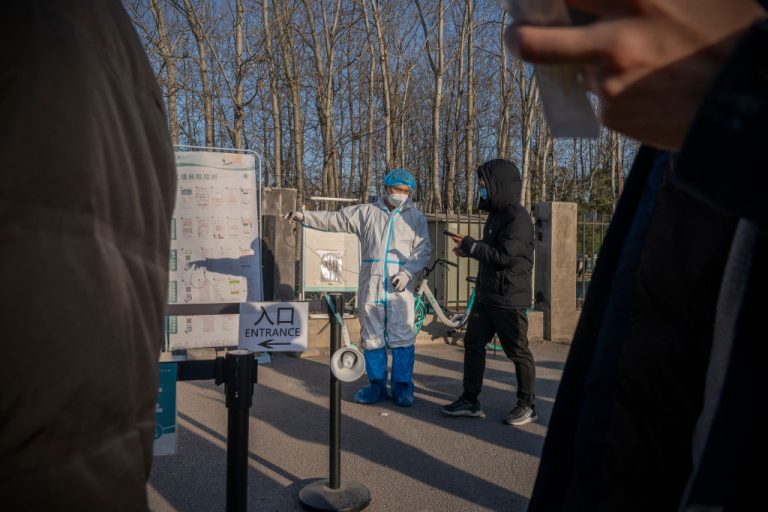COVID-19 outbreaks are spreading across first-tier cities in China such as Shenzhen, Shanghai, and Tianjin. Most recently, Tianjin, a city of 14 million located next to Beijing, reported 20 new cases in one day.
On Jan. 8, 20 cases were confirmed in Tianjin, with two of the cases reported to be from the Omicron variant. The two infected patients reportedly have no travel history and do not appear to be in the same transmission chain as Omicron cases previously found in the city, likely making them the first cases of the new variant originating in China.
A worsened outbreak in Tianjin
An announcement by the Chinese Health Commission revealed that 165 new cases were confirmed in China on Jan. 8, including four in Tianjin.
China’s national TV, CCTV, reported a much higher number from the Tianjin epidemic prevention briefing on Jan. 8, which said 18 cases had been found.
Zhang Ying, the director of the Tianjin Epidemic Control Center admitted that based on the relationship between cases and the chain of transmission, the virus had spread for at least 3 generations within the community. Zhang added that additional cases may be found outside of locked down areas.
Success
You are now signed up for our newsletter
Success
Check your email to complete sign up
The report also added that 2 more cases of Omicron were found, bringing the total number of new infections in Tianjin to 20 in one day.
Tianjin issues an important notice
As the outbreak in Tianjin becomes more alarming, city officials have issued an “Important Update” on Jan. 9.
The notice calls for comprehensive reinforcement of departures from Tianjin. People must have a negative nucleic acid test and a green health code within 48 hours in order to leave the city. Traffic in and out of the city will also be closely monitored.
In addition, all schools in the city will remain closed until further notice. On Jan. 10 -11, all teachers and students were told to stay at home and not allowed to leave unless for emergency situations. The notice added that after two days, an update will be provided.
Some local attractions have also announced the suspension of operations since Jan. 9. Tianjin Bus stations also received an urgent notice to suspend inter-provincial routes in Tianjin starting on Jan. 9.

Tianjin designates 7 medium-high risk areas
According to state-media Health Tianjin, as of Jan. 9, authorities in Tianjin have now designated one high-risk area and six medium-risk areas across the city.
Earlier, local officials acknowledged the uncertainty of the current outbreak and the severity and complexity of preventive measures in the city. Given the series of official actions in response to the outbreak, residents have begun to question whether officials are covering up the real number of local infections.
According to the state-run Global Times, due to the severity of the outbreak in Tianjin, authorities have initiated closed management in local communities. This means that all personnel in sealed off areas are required to stay indoors and wait for necessities to be delivered to their homes.
This has been the highest level of control enacted in China. On the morning of Jan. 9, Tianjin’s vegetable markets and grocery stores experienced a surge as residents resorted to panic buying in fear of a citywide lockdown as experienced in the cities of Xi’an and Yuzhou.
READ MORE:
Yuzhou: Second Chinese City Forced Into Total Lockdown Amid Government’s Zero-COVID Policy
90 Communities Locked Down in Xi’an, China After COVID-19 Spike; Grocery Shopping Allowed Once Every 2 Days
Beijing banning residents from Tianjin as Winter Olympics draw near
On Jan. 9, Chinese officials announced that the latest prevention measures targeting Tianjin would impact neighboring Beijing. This newest outbreak has raised concerns as to the safety of the upcoming Winter Olympics, scheduled to begin on Feb. 4.
As Tianjin and Beijing are geographically close to each other, the Chinese Communist Party (CCP) has repeatedly emphasized the “Jingjinji [combined abbreviations for Beijing-Tianjin-Hebei] integration” in the past. As a result, this outbreak of Omicron in Tianjin has caused panic across both cities and in the surrounding Hebei Province.
The Beijing Disease Control Center issued an emergency announcement on Jan. 9 requiring anyone traveling through Tianjin since Dec. 23 to take initiative in reporting to their communities, employers and places they have stayed in. In addition, the announcement encouraged residents to cooperate with PCR testing and other preventive measures. The notice also added that people in Beijing and Tianjin should not travel between the two cities unless absolutely necessary. Beijing-Tianjin commuters were also advised to work from home until the situation stabilizes.
According to China News Weekly, migration data provided by tech company Baidu shows that the top two destinations where Tianjin’s residents have moved to are Beijing and Hebei. Between Jan. 3 and Jan. 6, Beijing ranked first among Tianjin’s moving-out destinations. On Jan. 4, the moving-out rate from Tianjin to Beijing reached a rate of 32.09 percent at its highest.
Several Chinese epidemiologists have also admitted that the current outbreak situation in China is volatile and that it will be very difficult to achieve the official “Zero-COVID” policy as mandated by the government.







